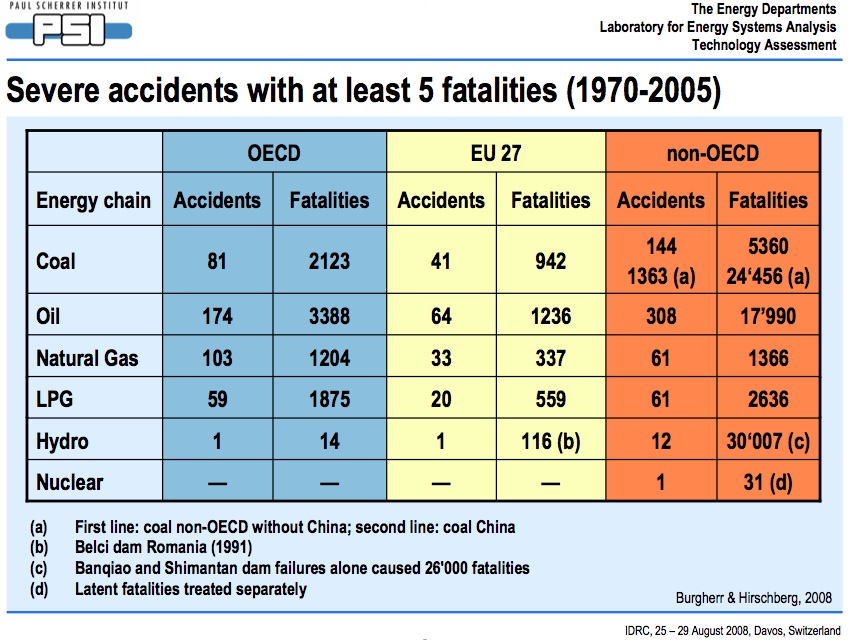There has never been a civilian fatality in an OECD nuclear power plant. Even accounting for the terrible accident at Chernobyl and the Fukushima and Three Mile Island accidents, nuclear energy has had the fewest accidents and fatalities of any of the major power generating technologies.
The nuclear industry has an excellent safety record, with some 13,000 reactor years of operation spanning five decades. Even a major accident and meltdown in a typical reactor would not endanger its neighbours from radiation.
The evidence for this is contained in 2012 report from the US Nuclear Regulatory Commission titled the “State-of-the-Art Reactor Consequence Analyses (SOARCA) Project”. The main report is accession number ML12332A057 (warning – link is to a 40 MB pdf). Here is the BLUF (bottom line up front) from the Conclusions section of the report (page 85) documenting the project’s results:
- Individual early fatality risk is essentially zero
- Individual latent cancer risk from the important scenarios is thousands of times lower than the NRC Safety Goal and millions of times lower than all other cancer risks, even assuming the LNT dose response model.
(Emphasis added). A layman’s explanation of the report can be found at this discussion page at the excellent atomicinsights.com
One important outcome would be to confirm that there is no need for an emergency evacuation from the vicinity of a major incident at a nuclear power station as the immediate impacts will be negligible. Any required evacuation can be conducted in an orderly and timely fashion, reducing the risk of unnecessary injury due to panic or otherwise.
Some Soviet designed and built reactors have been a safety concern for many years, but are much better now than in 1986. The Chernobyl disaster was basically irrelevant to any western reactor, or any that might be built today.
According to authoritative UN figures, the Chernobyl death toll is 61 (31 workers at the time, more since and 9 from thyroid cancer).
Although Chernobyl blemished the image of nuclear energy, the accident’s positive legacy is an even stronger system of nuclear safety worldwide. In 1989, the nuclear industry established the World Association of Nuclear Operators (WANO) to foster a global nuclear safety culture. Through private-sector diplomacy, WANO has built a transnational network of technical exchange that includes all countries with nuclear power. Today every nuclear power reactor in the world is part of the WANO system of operational peer review. The aim of WANO’s peer-review system standards set by the UN’s International Atomic Energy Agency (IAEA).
It is worthwhile visiting this nuclear safety information from the World Nuclear Association, which provides extensive detail on the whole area of nuclear safety.
Advances in safety practice are unmistakable. At most plants worldwide, reportable safety-related ‘events’ are now near zero. National and international insurance laws assign responsibility to nuclear plant operators. In the U.S. for example, reactor operators share in a ‘pooled’ private insurance system that has never cost taxpayers a cent.
Today, nuclear power plants have a superb safety record – both for plant workers and the public. In the transport of nuclear material, highly engineered containers – capable of withstanding enormous impact – are the industrial norm. More than 20,000 containers of spent fuel and high-level waste have been shipped safely over a total distance exceeding 30 million kilometres. During the transport of these and other radioactive substances – whether for research, medicine or energy- there had never been a harmful radioactive release.
Radiation is released naturally from the ground and atmosphere in all places on Earth. This ‘natural background’ radiation, which varies considerably from region to region, is part of the environment to which all human beings are conditioned. Like many things, radiation can be both beneficial and harmful. Large doses are dangerous. Abundant evidence indicates that small doses are harmless.
The radiation produced within the core of nuclear reactors is similar to natural radiation but more intense. At nuclear power plants, protective shielding isolates this radiation, allowing millions of people to live safely nearby. Typically, the radiation people receive comes 85% from nature and 15% from medical exposures. Radiation exposure from nuclear power is negligible.
The table below is from a 2008 International Disaster and Risk Conference and shows how there has never been a civilian fatality in an OECD nuclear power plant. It shows that, even accounting for the terrible accident at Chernobyl and the Three Mile Island accident, nuclear energy has had the fewest accidents and fatalities of any of the major power generating technologies.
